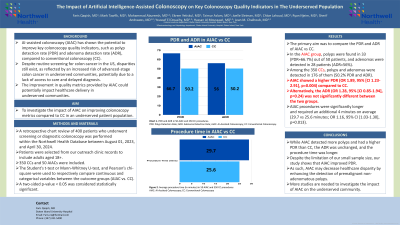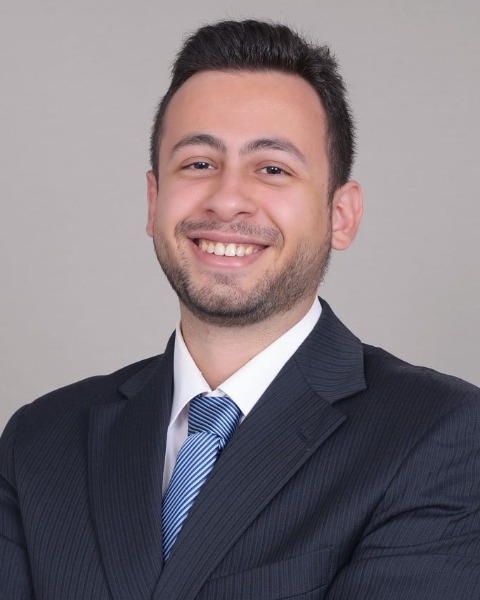Tuesday Poster Session
Category: Colon
P3638 - The Impact of Artificial Intelligence-Assisted Colonoscopy on Key Colonoscopy Quality Indicators in the Underserved Population
Tuesday, October 29, 2024
10:30 AM - 4:00 PM ET
Location: Exhibit Hall E

Has Audio

Faris Qaqish, MD
Staten Island University Hospital, Northwell Health
Staten Island, NY
Presenting Author(s)
Faris Qaqish, MD, Mark Tawfik, DO, Mohammad Abureesh, MD, Ekrem Yetiskul, DO, Taimur Aslam, MD, Joelle Sleiman, MD, Chloe Lahoud, MD, Ryan Njeim, MD, Stefan Hamaway, MD, Sherif Andrawes, MD, Youssef El Douaihy, MD, Hassan Al Moussawi, MD, Jean M. Chalhoub, MD
Staten Island University Hospital, Northwell Health, Staten Island, NY
Introduction: AI-assisted colonoscopy (AIAC) has shown the potential to improve key colonoscopy quality indicators, such as polyp detection rate (PDR) and adenoma detection rate (ADR), compared to conventional colonoscopy (CC). This improvement in quality metrics could potentially impact healthcare delivery in underserved communities. We investigated the impact of AIAC on improving colonoscopy metrics compared to CC in an underserved patient population.
Methods: A retrospective chart review of 400 patients who underwent screening or diagnostic colonoscopy was performed within the Northwell Health Database between August 01, 2023, and April 30, 2024. Patients were selected from our outreach clinic records to include adults aged 18+. 350 CCs and 50 AIACs were included. Colonoscopy and pathology reports were reviewed for data collection. The Student’s t-test or Mann-Whitney U-test, and Pearson’s chi-square were used to respectively compare continuous and categorical variables between the outcome groups (AIAC vs. CC). A two-sided p-value < 0.05 was considered statistically significant. The primary aim was to compare the PDR and ADR of AIAC vs CC.
Results: Polyps were found in 33 (PDR=66.7%) out of 50 patients in the AIAC group, and adenomas were detected in 28 patients (ADR=56%). Among the 350 CCs, polyps and adenomas were detected in 176 of them (50.2% PDR and ADR). AIAC showed a higher PDR (OR 1.89, 95% [CI 1.23-2.91], p=0.004) when compared to CC. Alternatively, the ADR (OR 1.28, 95% [CI 0.85-1.94], p=0.24) was not significantly different between the 2 groups. AIAC procedures were significantly longer and required an additional 4 minutes on average (29.7 vs 25.6 minutes; OR 1.16, 95% CI [1.03-1.30], p=0.013).
Discussion: While AIAC detected more polyps and had a higher PDR than CC, the ADR was unchanged, and the procedure time was longer. Despite routine screening for colon cancer in the US, disparities still exist, as reflected by an increased risk of advanced-stage colon cancer in underserved communities, potentially due to a lack of access to care and delayed diagnosis. Despite the limitation of our small sample size, our study shows that AIAC improved PDR. As such, AIAC may decrease healthcare disparity by enhancing the detection of premalignant non-adenomatous polyps. More studies are needed to investigate the impact of AIAC on the underserved community.
Disclosures:
Faris Qaqish, MD, Mark Tawfik, DO, Mohammad Abureesh, MD, Ekrem Yetiskul, DO, Taimur Aslam, MD, Joelle Sleiman, MD, Chloe Lahoud, MD, Ryan Njeim, MD, Stefan Hamaway, MD, Sherif Andrawes, MD, Youssef El Douaihy, MD, Hassan Al Moussawi, MD, Jean M. Chalhoub, MD. P3638 - The Impact of Artificial Intelligence-Assisted Colonoscopy on Key Colonoscopy Quality Indicators in the Underserved Population, ACG 2024 Annual Scientific Meeting Abstracts. Philadelphia, PA: American College of Gastroenterology.
Staten Island University Hospital, Northwell Health, Staten Island, NY
Introduction: AI-assisted colonoscopy (AIAC) has shown the potential to improve key colonoscopy quality indicators, such as polyp detection rate (PDR) and adenoma detection rate (ADR), compared to conventional colonoscopy (CC). This improvement in quality metrics could potentially impact healthcare delivery in underserved communities. We investigated the impact of AIAC on improving colonoscopy metrics compared to CC in an underserved patient population.
Methods: A retrospective chart review of 400 patients who underwent screening or diagnostic colonoscopy was performed within the Northwell Health Database between August 01, 2023, and April 30, 2024. Patients were selected from our outreach clinic records to include adults aged 18+. 350 CCs and 50 AIACs were included. Colonoscopy and pathology reports were reviewed for data collection. The Student’s t-test or Mann-Whitney U-test, and Pearson’s chi-square were used to respectively compare continuous and categorical variables between the outcome groups (AIAC vs. CC). A two-sided p-value < 0.05 was considered statistically significant. The primary aim was to compare the PDR and ADR of AIAC vs CC.
Results: Polyps were found in 33 (PDR=66.7%) out of 50 patients in the AIAC group, and adenomas were detected in 28 patients (ADR=56%). Among the 350 CCs, polyps and adenomas were detected in 176 of them (50.2% PDR and ADR). AIAC showed a higher PDR (OR 1.89, 95% [CI 1.23-2.91], p=0.004) when compared to CC. Alternatively, the ADR (OR 1.28, 95% [CI 0.85-1.94], p=0.24) was not significantly different between the 2 groups. AIAC procedures were significantly longer and required an additional 4 minutes on average (29.7 vs 25.6 minutes; OR 1.16, 95% CI [1.03-1.30], p=0.013).
Discussion: While AIAC detected more polyps and had a higher PDR than CC, the ADR was unchanged, and the procedure time was longer. Despite routine screening for colon cancer in the US, disparities still exist, as reflected by an increased risk of advanced-stage colon cancer in underserved communities, potentially due to a lack of access to care and delayed diagnosis. Despite the limitation of our small sample size, our study shows that AIAC improved PDR. As such, AIAC may decrease healthcare disparity by enhancing the detection of premalignant non-adenomatous polyps. More studies are needed to investigate the impact of AIAC on the underserved community.
Disclosures:
Faris Qaqish indicated no relevant financial relationships.
Mark Tawfik indicated no relevant financial relationships.
Mohammad Abureesh indicated no relevant financial relationships.
Ekrem Yetiskul indicated no relevant financial relationships.
Taimur Aslam indicated no relevant financial relationships.
Joelle Sleiman indicated no relevant financial relationships.
Chloe Lahoud indicated no relevant financial relationships.
Ryan Njeim indicated no relevant financial relationships.
Stefan Hamaway indicated no relevant financial relationships.
Sherif Andrawes indicated no relevant financial relationships.
Youssef El Douaihy indicated no relevant financial relationships.
Hassan Al Moussawi indicated no relevant financial relationships.
Jean Chalhoub indicated no relevant financial relationships.
Faris Qaqish, MD, Mark Tawfik, DO, Mohammad Abureesh, MD, Ekrem Yetiskul, DO, Taimur Aslam, MD, Joelle Sleiman, MD, Chloe Lahoud, MD, Ryan Njeim, MD, Stefan Hamaway, MD, Sherif Andrawes, MD, Youssef El Douaihy, MD, Hassan Al Moussawi, MD, Jean M. Chalhoub, MD. P3638 - The Impact of Artificial Intelligence-Assisted Colonoscopy on Key Colonoscopy Quality Indicators in the Underserved Population, ACG 2024 Annual Scientific Meeting Abstracts. Philadelphia, PA: American College of Gastroenterology.
